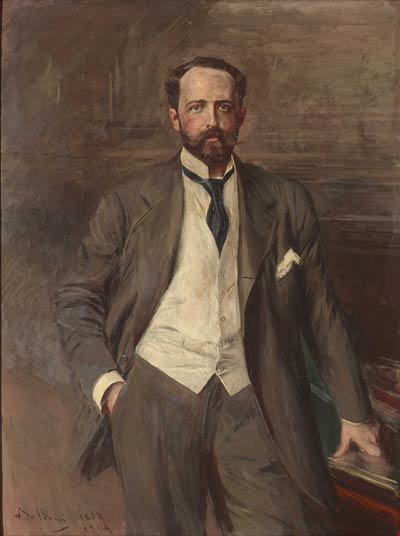|
 |
Giovanni BOLDINI
(Ferrara 1842 - Paris 1931)
Portrait
of Marchese Ignazio Boncompagni, Prince of
Venosa, 1914
Oil on canvas, 130 x 95 cm
Signed and dated bottom left: Boldini
1868 / 1914
Provenance: Turin, Accorsi Collection;
Turin, private collection; Rome, private collection.
Literature:
Boldini, curated by Ettore Camesasca,
Alessandra Bargogelli, catalogo della mostra,
Milano, Palazzo della Società per le
Belle Arti ed Esposizione Permanente, 22 March
- 14 May 1989, Milano, Mazzotta, 1989; C.L.
Ragghianti and E. Camesasca, L’opera
completa di Boldini, Milan, Rizzoli, 1970,
p. 129, plate 527; F. Dini and P. Dini, Giovanni
Boldini 1842-1931. Reasoned catalogue, Turin,
Allemandi, 2002, p. 558, plate 1087.
Exhibition: Boldini, curated by
Ettore Camesasca, Alessandra Bargogelli, catalogo
della mostra, Milano, Palazzo della Società
per le Belle Arti ed Esposizione Permanente,
22 March - 14 May 1989, Milano, Mazzotta,
1989, pag. 211, plate 142.
|
|
Giovanni
Boldini was born to painter Antonio Boldini and to
Benvenuta Caleffi in Ferrara on 31 December 1842.
He devoted his energies to the study of drawing, under
his father's guiding hand, at a very early age. But
apart from his father's example, and of course the
work of the Ferrarese painters of the Renaissance
which he studied and copied as a young boy, he found
little in the way of stimulus in a small town such
as Ferrara, which turned its back on any form of innovation.
Thus using money he had inherited from an uncle in
the church, he decided in 1862 to travel to Florence,
which was one of the most culturally effervescent
cities in Italy at the time. In his new home he began
to frequent Macchaiaoli circles, but he preferred
portraiture to the depiction of nature, having devoted
his energies to the genre with some success in Ferrara,
and so he resumed portrait painting with renewed vigour
in Florence.
His soon began to receive commissions from wealthy
merchants, one of whom was Sir Walter Falconer, and
it was Falconer who offered him the chance to visit
Paris for the first time in 1867. After initially
travelling to London, Boldini decided in 1871 to settle
permanently in the French capital, where he began
with some assiduity to frequent fashionable society
rather than the city's intellectual circles. He was
forced to leave the city when war broke out, but he
returned to Paris as soon as the fighting was over
and spent the last years of his life there.
His
style changed noticeably over the years. His brushwork
became impetuous and violent, and he began to handle
his subjects with an extreme, almost off-hand kind
of breeziness, whether they were horses on the move,
the audience in a theatre, passers-by on the street,
or landscapes and cityscapes. He produced an increasingly
large number of portraits of illustrious personalities,
the best-known examples of which include Robert de
Montesquiou and Giuseppe Verdi, but the true stars
of his art were the elegant ladies of high society,
including Emiliana Conca de Ossa, Lina Cavalieri,
Cléo de Mérode and the Marchesa Casati.
His decision to make these sitters the driving force
behind the promotion of his art has led many critics
since his death to accuse him of making far too many
concessions to the frivolity and fashions of the Belle
Époque, yet this in no way detracts from Boldini's
greatness as a portrait painter who was capable of
capturing and conveying not only his sitters' splendid
costumes but also their deeper pyschological traits.
This
splendid portrait of Marchese Ignazio Boncompagni,
Prince of Venosa, perfectly encapsulates the unique
compositional features typical of Boldini's portraiture.
Once again the sitter is a well-known figure of high
society, an aristocrat who played a leading role in
politics and culture in Rome in the second half of
the 19th century.
Ignazio Boncompagni was born in Rome on 27 May 1845,
the second son of Antonio, Prince of Piombino. The
young man inherited from his father both his liberal
convictions and a strong sense of patriotism, joining
Garibaldi's forces at only twenty-two years of age
and taking part in the Mentana and Monterotondo campaigns
to liberate Rome in 1867. He was a member of the provisional
government appointed by General Cadorna in 1870, which
prepared to annex Rome to the new Kingdom of Italy.
In the years thereafter he held important public office
and was raised to the Senate in 1886. In 1868 he had
married Teresa Mariscotti, an elegant aristocrat who,
like him, loved culture and Rome society. The couple
never had any children, as we can tell in particular
from the fact that parliament sent its condolences
on the Marchese's death to his widow alone (see: Senato
del Regno Atti parlamentari. Discussioni, 1 December
1913).
The portrait is signed and bears two dates –
1868 and 1914 – bottom right. The second date
refers in all likelihood to the year in which the
picture was painted, while the first coincides with
the year of the marriage of the sitter, who had wed
Teresa Mariscotti precisely in 1868. Given that we
know the Marchese died in October 1913, there is a
clear inconsistency between that date and the year
in which the portrait was painted, which is given
as 1914. Boldini almost certainly began to work on
the picture in the spring of 1913, when he is known
to have been in Rome, while be must have finished
it in 1914, before leaving the city after the outbreak
of the First World War. The painting is likely to
have been finished using a portrait or a photograph
of the Marchese supplied by his widow, who may well
have asked for the date of their marriage to be added
to the painting in memory of her lifetime union with
her beloved late husband.
|
|